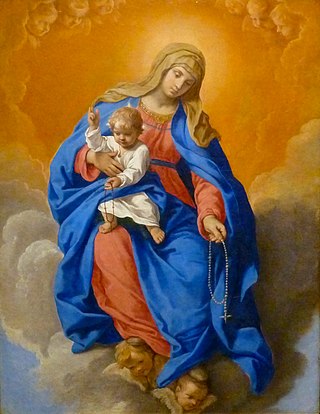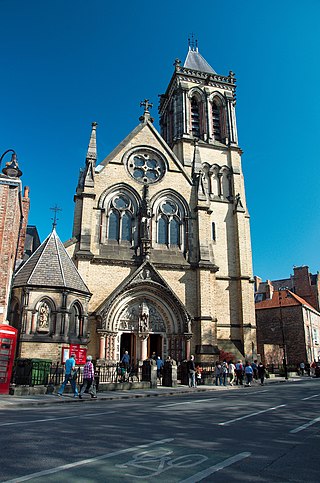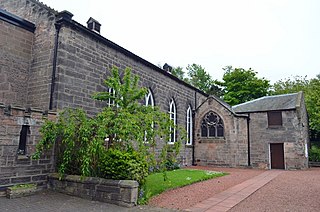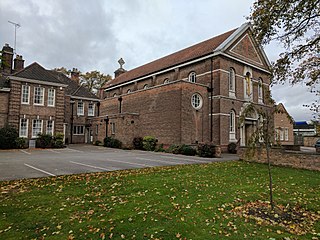
Carfin Lourdes Grotto, a Roman Catholic shrine in Scotland dedicated to Our Lady of Lourdes, was created in the early twentieth century. The "Carfin Grotto", as the shrine is locally referred to, was the brainchild of Father, later Canon Thomas N. Taylor, parish priest of St. Francis Xavier's Parish in the small, mining village of Carfin, which lies two miles east of Motherwell, in the West of Scotland. Following a trip to France's principal Marian shrine at Lourdes, Canon Taylor's vision was to build a religious memorial in honour of Our Blessed Lady based on the template of the Grotto of Massabielle. To realize this vision became his life's work. Since its opening in the early 1920s, the "grotto" has attracted pilgrims in the hundreds of thousands and its environs have been modified and enhanced with rich Catholic symbols and buildings. The grotto shrine offers a pilgrimage season with Sunday processions, rosaries, outdoor Masses and dedicated Feast Day events which run annually from early May until late September.

The Catholic Diocese of Westminster is an archdiocese of the Latin Church of the Catholic Church in England. The diocese consists of most of London north of the River Thames and west of the River Lea, the borough of Spelthorne, and the county of Hertfordshire, which lies immediately to London's north.

Brompton Oratory is a large neo-classical Roman Catholic church in the Knightsbridge area of the Royal Borough of Kensington and Chelsea, London. Its full name is the Church of the Immaculate Heart of Mary, or as named in its Grade II* architectural listing, The Oratory. The church is closely connected with the London Oratory School, a school founded by the priests from the London Oratory. Its priests celebrate Mass daily in both the Ordinary and Extraordinary forms, frequently conduct ceremonies for well-known people, as it works as an extra-parochial church. There are three choirs at the church.

The London Oratory is a Catholic community of priests living under the rule of life established by its founder, Philip Neri (1515-1595). It is housed in an Oratory House, next to the Church of the Immaculate Heart of Mary in the Brompton Road, Royal Borough of Kensington and Chelsea, London, SW7.

Our Lady of the Rosary, also known as Our Lady of the Holy Rosary, is a Marian title.

George Goldie was an English ecclesiastical architect who specialised in Roman Catholic churches.

The Cathedral of Saint Joseph is the mother church for the Roman Catholic Diocese of Jefferson City in Missouri. The cathedral serves as the parish church for the bishop, who is currently the Most Reverend Shawn McKnight, the fourth bishop of Jefferson City. The cathedral sits on a 25-acre (100,000 m2) site that also includes a former Carmelite monastery, the Alphonse J. Schwartze Memorial Catholic Center, St. Joseph Cathedral School, and the Cathedral of Saint Joseph parish offices, which were formerly a convent that housed the Sisters of Mercy. The current pastor is the Reverend Fr. Louis Nelen.

Our Lady of Lourdes church is the Catholic parish church for Wanstead in the London Borough of Redbridge and parts of Leytonstone in the London Borough of Waltham Forest. The parish is part of the Diocese of Brentwood.

The Parish Church of St Mary and St Augustine in Stamford, Lincolnshire, England, is home to a congregation of the Roman Catholic Diocese of Nottingham. St Augustine's was designed in a "robust High Victorian Early English" style by George Goldie, one of the foremost Catholic architects in England in the nineteenth century. It was built over 1862-64 and while much of its Victorian interior was stripped out in the middle decades of the twentieth century, it still retains some furnishings and fittings of distinction.

The Church of Our Lady and St Peter is a Roman Catholic church in Leatherhead, Surrey. It was founded as a local chapel during the First World War and later became a Parish church. It is situated between Copthorne Road and Garlands Road on the junction with St John's Avenue in Leatherhead. It is the only Catholic church in Leatherhead and is served by the Diocese of Arundel and Brighton.

Our Lady of Sorrows Church or its full name Our Lady of Seven Sorrows Church is a Roman Catholic parish church in Dolgellau, Gwynedd. It was built in 1966 and is a Grade II listed building. It is situated on Meyrick Street close to the centre of town. It is administered in the Dolgellau Deanery of the Diocese of Wrexham.

The Church of Our Lady of the Assumption and St Gregory is a Catholic church on Warwick Street, Westminster. It was formerly known as the Royal Bavarian Chapel, because like several Catholic churches in London it originated as a chapel within a foreign embassy. It was built between 1789 and 1790 to the designs of Joseph Bonomi the Elder. The only surviving eighteenth-century Catholic chapel in London, it is a Grade II* listed building. The parish is now operated by the Personal Ordinariate of Our Lady of Walsingham, the British personal ordinariate for the Anglican Use within the Catholic Church.

Our Lady of Ransom Church is a Roman Catholic Parish church in Eastbourne, East Sussex. It was founded as a mission in 1869, built from 1900 to 1903, and had extensions completed in 1926. It is situated on the corner of Meads Road and Grange Road, opposite Eastbourne Town F.C. in the centre of the town. It was designed by Frederick Walters and is a Grade II listed building.

The church of Our Lady of Mount Carmel and St Simon Stock is a Roman Catholic church at 41 Kensington Church Street, Kensington, London W8, served by Discalced Carmelites.

The Shrine of Our Lady of Consolation or Church of Our Lady of Consolation and Saint Francis is a Roman Catholic parish church in West Grinstead, in West Sussex. It was built from 1875 to 1876, with additions made to the church in 1896 and 1964. The church was designed by John A. Crawley and the 1896 additions was designed by Frederick Walters. It is situated on the corner of Steyning Road and Park Lane to the east of the A24 road. It is a Gothic Revival style church and a Grade II listed building.
Our Lady of Dolours, also known as the Servite Church, is a Roman Catholic parish church run by the Servite Order in Chelsea, central London. The building was designed in Gothic Revival style by J. A. Hansom in 1873. It is Grade II listed with Historic England. It stands next to St Mary's Priory, at 264 Fulham Road close to the South Lodge entrance to Brompton Cemetery in the Royal Borough of Kensington and Chelsea. There is a mixed Roman Catholic primary school adjacent to the church and priory.

Our Lady and St Cuthbert Church is a Roman Catholic parish church in Berwick-upon-Tweed, Northumberland, England. It was built in 1829 in the Gothic Revival style, intentionally hidden away from the street. It is located on Ravensdowne to the south of Berwick Barracks in the centre of the town. It is a Grade II listed building.

St Philip Neri Church is a Roman Catholic parish church in Mansfield, Nottinghamshire, England. It was founded by Edward Bagshawe, Bishop of Nottingham. It was built from 1924 to 1925 and designed by Charles A. Edeson and was influenced by Brompton Oratory, where Bishop Bagshawe formerly served. It is located on Chesterfield Road South to the north of the town centre. It is in the Italian Baroque style and is a Grade II listed building.

Our Lady and St Edmund's Church is a Roman Catholic parish church in Abingdon-on-Thames, Oxfordshire, England. It was built in 1857, designed by William Wardell and George Goldie and paid for by Sir George Bowyer, 7th Baronet in the Gothic Revival style. It is located on the corner of Radley Road and Oxford Road near the town centre.





















